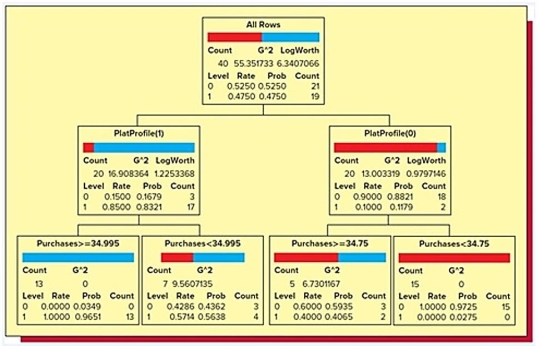Suppose that a bank wishes to predict whether or not an existing holder of its Silver credit card will upgrade, for an annual fee, to its Platinum credit card. To do this, the bank carries out a pilot study that randomly selects 40 of its existing Silver card holders and offers each Silver card holder an upgrade to its Platinum card. Here, the response variable Upgrade equals 1 if the Silver card holder decided to upgrade and 0 otherwise. Moreover, the predictor variable Purchases is last year's purchases (in thousands of dollars) by the Silver card holder, and the predictor variable PlatProfile equals 1 if the Silver card holder conforms to the bank's Platinum profile and 0 otherwise. Below is the classification tree they derived from the data collected in the study.  Of these 40 Silver card holders, what is the proportion that did not upgrade?
Of these 40 Silver card holders, what is the proportion that did not upgrade?
A) .5535
B) .5250
C) .4750
D) .1179
E) .1000
Correct Answer:
Verified
Q16: Classification involves identifying common traits in items
Q17: The nearest neighbors to an observation are
Q18: The best value of k to use
Q19: The confusion matrix is not a good
Q20: A classification tree is useful for predicting
Q22: Suppose that a bank wishes to predict
Q23: Unlike a classification tree, a regression tree
Q24: An internet service provider (ISP) has randomly
Q25: An internet service provider (ISP) has randomly
Q26: Which of the following possible response variables
Unlock this Answer For Free Now!
View this answer and more for free by performing one of the following actions

Scan the QR code to install the App and get 2 free unlocks

Unlock quizzes for free by uploading documents